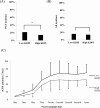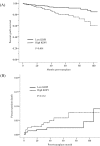Clinical significance of the Kidney Donor Profile Index in deceased donors for prediction of post-transplant clinical outcomes: A multicenter cohort study
- PMID: 30289927
- PMCID: PMC6173429
- DOI: 10.1371/journal.pone.0205011
Clinical significance of the Kidney Donor Profile Index in deceased donors for prediction of post-transplant clinical outcomes: A multicenter cohort study
Abstract
Background: We investigated whether the Kidney Donor Profile Index (KDPI) system is useful in predicting clinical outcomes in deceased donor kidney transplantation (DDKT).
Methods: Four hundred sixty-nine kidney transplant recipients (KTRs) receiving kidneys from 359 deceased donors were included in this study, which involved three transplant centers. KTRs were divided into high and low KDPI KTR groups based on the median KDPI score of 67%. We compared clinical outcomes between the high KDPI and low KDPI groups.
Results: There were no significant differences in the incidence of delayed graft function and acute rejection between high and low KDPI KTR groups. In comparison with histologic findings in allograft tissues obtained within three months from KT, the proportion of glomerulosclerosis was significantly higher in the high KDPI KTR group than in the low KDPI KTR group. With Kaplan-Meier analysis, the graft survival rate was significantly lower in the high KDPI KTR group than in the low KDPI KTR group (Log rank, P = 0.017), and multivariate analysis also demonstrated that a high KDPI score was a significant risk factor for death censored allograft failure (HR 2.62, 95% CI, 1.29-5.33, P = 0.008).
Conclusion: The KDPI scoring system is useful in predicting allograft outcomes in a Korean DDKT cohort.
Conflict of interest statement
The authors have declared that no competing interests exist.
Figures




References
-
- Jin DC, Yun SR, Lee SW, Han SW, Kim W, Park J. Current characteristics of dialysis therapy in Korea: 2015 registry data focusing on elderly patients. Kidney research and clinical practice. 2016;35(4):204–11. Epub 2016/12/14. 10.1016/j.krcp.2016.09.006 ; PubMed Central PMCID: PMCPMC5142391. - DOI - PMC - PubMed
-
- Said MR, Curtis JJ. Living unrelated renal transplantation: progress and potential. Journal of the American Society of Nephrology: JASN. 1998;9(11):2148–52. Epub 1998/11/10. . - PubMed
-
- Gonzalez-Segura C, Castelao AM, Torras J, Moreso F, Riera L, Lopez-Costea MA, et al. A good alternative to reduce the kidney shortage: kidneys from nonheartbeating donors. Transplantation. 1998;65(11):1465–70. Epub 1998/06/30. . - PubMed
-
- Bunnapradist S, Gritsch HA, Peng A, Jordan SC, Cho YW. Dual kidneys from marginal adult donors as a source for cadaveric renal transplantation in the United States. Journal of the American Society of Nephrology: JASN. 2003;14(4):1031–6. Epub 2003/03/28. . - PubMed
Publication types
MeSH terms
LinkOut - more resources
Full Text Sources
Medical

